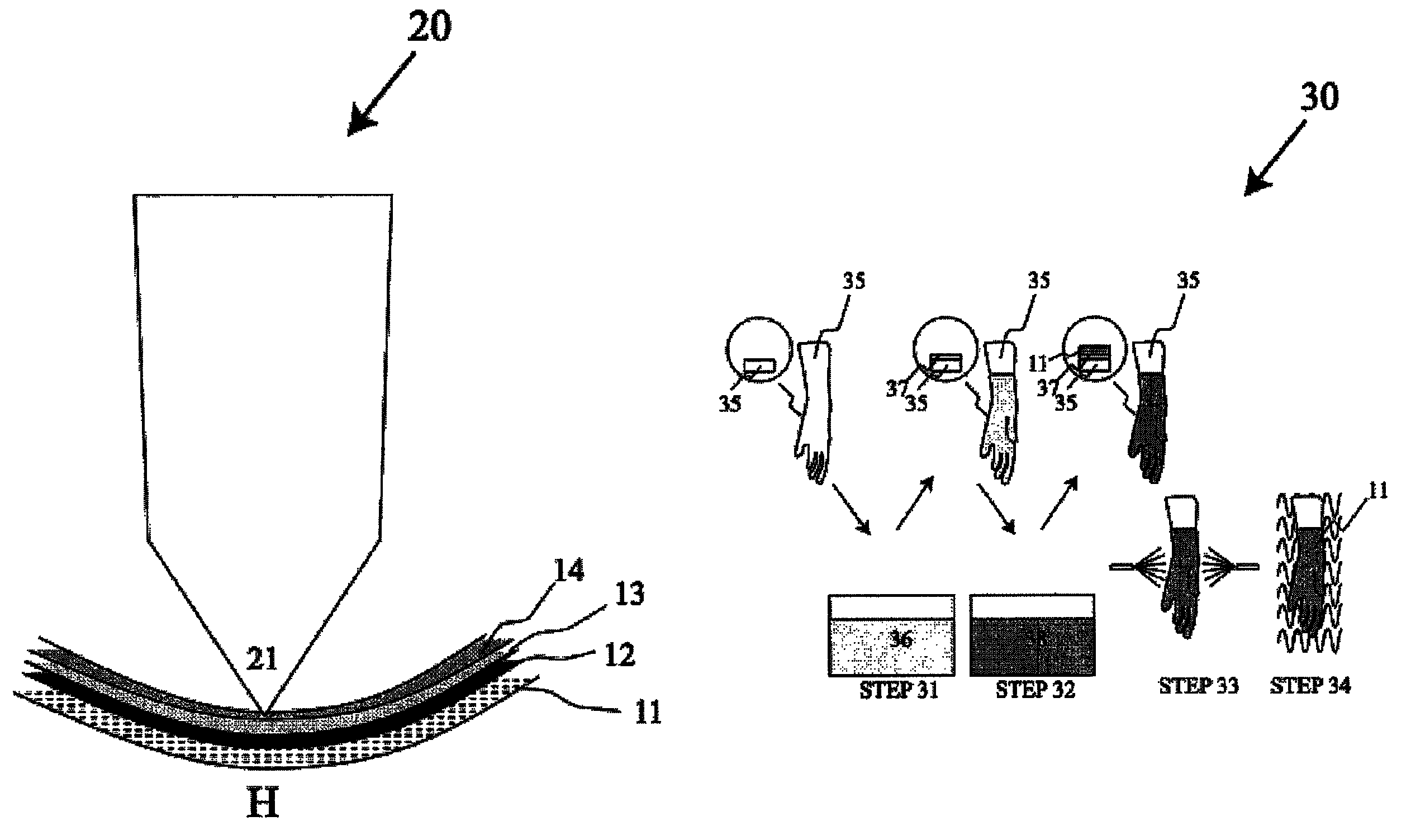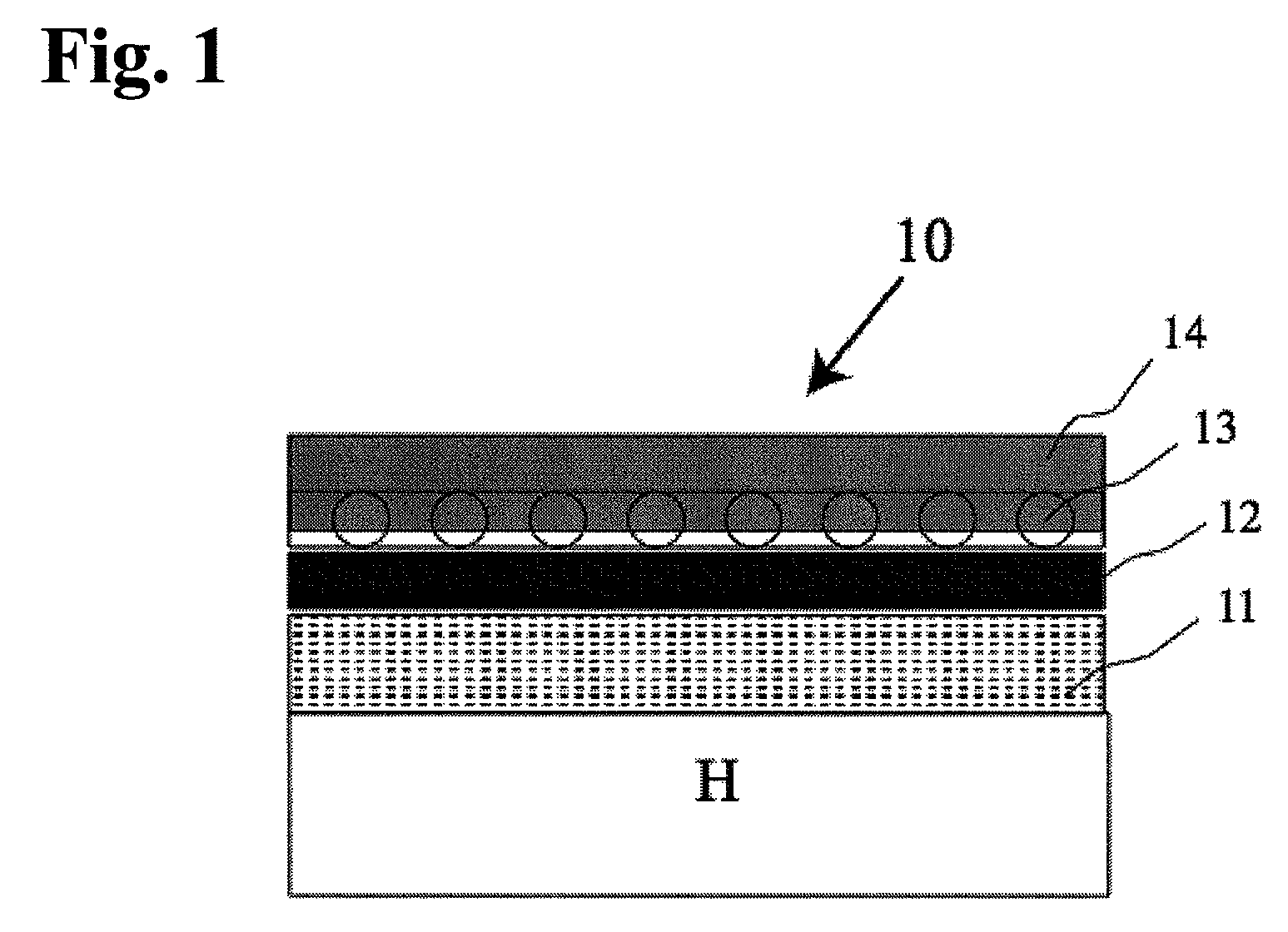[0015]Provided are cut resistant chemical handling latex gloves and methods of making and using the same. These gloves are flexible and lightweight. To a cured, liquid-impervious polymeric latex shell, a tacky adhesive coating with low shear strength is applied. A cut resistant liner is slipped on the tacky adhesive coating and is infiltrated with a polymeric latex coating and cured to integrally attach the cut resistant liner with the cured polymeric coating. When the latex glove is worn on a hand and a cutting edge, such as a knife edge, contacts the glove, a crease is formed due to slip at the tacky adhesive-cut resistant liner interface creating a geometry that reduces cut stress intensity at the knife-edge thereby increasing the cut resistance of the glove.
[0016]In one or more embodiments, provided is a latex glove comprising a cured, liquid-impervious chemical resistant nitrile or polychloroprene polymeric shell substantially free from defects; at least one cut resistant liner comprising cut resistant strand; a tacky pressure sensitive continuous adhesive layer placed between the shell and the cut resistant liner; and a polymeric coating having a thickness penetrating the interstices of the cut resistant liner that integrally encases the cut resistant liner and may extend beyond the liner surface distal from the tacky adhesive layer. When the glove is worn, with the liquid-impervious chemical resistant polymeric shell being proximate to the hand, and a knife contacts the polymeric coating, the interface between the cut resistant liner integrally encased in the polymeric coating and the tacky adhesive layer behaves as a slip interface creating a crease that increases the contact area between the cut resistant liner and the knife edge thereby reducing the overall stress intensity at the cutting edge. As a result, a much larger force is needed to create a cut in the glove article. The integrity of the liquid-impervious chemical resistant polymeric shell is maintained to a greater extent than a cut resistant liner that integrally attached to a polymeric shell and has no slip interface and taut cut resistant liner experiences higher stress level at the cutting edge creating a cut at a lower knife edge force.
[0017]Methods are provided that comprise forming a cured, liquid-impervious polymeric latex shell; coating the polymeric shell with a tacky adhesive coating; forming a lubricating surface by temporarily rendering the tacky adhesive coating not tacky; placing a cut resistant liner over the lubricating surface; restoring tackiness to the lubricating surface to provide the tacky adhesive coating; forming an integral cut resistant liner by infiltrating the cut resistant liner with a polymeric coating; anchoring the integral cut resistant linter to the tacky adhesive; and thereby forming the glove, which upon placing the glove on a hand and contacting a cutting edge on the glove, the integral cut resistant liner slips on the tacky adhesive, thereby reducing cutting stress at the cutting edge.
[0018]In one or more embodiments, methods for the manufacture of a cut resistant chemically protective latex article comprise providing a soft liquid-impervious chemical resistant nitrile or polychloroprene polymeric shell typically having a thickness in the range of 9 to 13 mils, covering the hands and forearm of a user in a so-called gauntlet configuration, that is coated with a tacky adhesive coating typically having a thickness in the range of 1 to 5 mil, slipping a cut resistant liner typically in the range of 15 to 30 mil slipped over the tacky adhesive layer, and forming a dipped polymeric coating having a thickness in the range of 15 to 35 mil that encapsulates the cut resistant liner and extends beyond the liner. The overall thickness of the latex glove article is in the range of 50 to 75 mils and is extremely soft and flexible in spite of its thickness due to compliance provided by the tacky adhesive layer contacting the cut resistant liner that is integrally attached to the polymeric coating. The method can comprise providing a cured, liquid-impervious, nitrile or polychloroprene polymeric shell produced by dipping a coagulant-coated former into an aqueous latex emulsion, coagulating a latex layer on the former, and heating the coagulated latex layer on the former to crosslink and cure the latex layer. The method can further comprise providing a continuous tacky styrene acrylic adhesive coating on the outer surface of the polymeric shell that is distal from the skin contacting surface by dipping the liquid-impervious nitrile or polychloroprene polymeric shell on the former in a water-based styrene acrylic solution and drying to form the tacky coating. The method further comprises wetting the tacky adhesive outer surface to disable the tackiness and dressing or inserting a cut resistant liner over the adhesive layer to form a polymeric shell assembly. Drying the polymeric shell assembly restores adhesive tackiness and fixes the attachment of the cut resistant liner to the tacky adhesive layer. In one or more embodiments, this polymeric shell assembly is coated first with a coagulant and dipped into a bath of nitrile or polychloroprene aqueous emulsion producing a polymeric coating that encapsulates the cut resistant liner. The polymeric coating may extend beyond the cut resistant liner, but does not reach or penetrate the tacky adhesive coating, it may, however, reach the tacky adhesive layer-cut resistant liner interface. The polymeric coating of nitrile or neoprene latex is thermally cured. Further aspects include methods of providing improved hand safety, the methods comprising: donning a cut resistant and chemical resistant latex glove, the glove comprising a cured, liquid-impervious polymeric latex shell, said polymeric shell coated with a tacky adhesive coating; and a coated cut resistant liner in contact with said tacky adhesive coating, the coated cut resistant liner comprising a cut resistant liner infiltrated with a polymeric coating; and applying a loading from a cutting edge to the glove such that the coated cut resistant liner slips on the tacky adhesive and thereby reduces cutting stress at the cutting edge.
 Login to View More
Login to View More 


